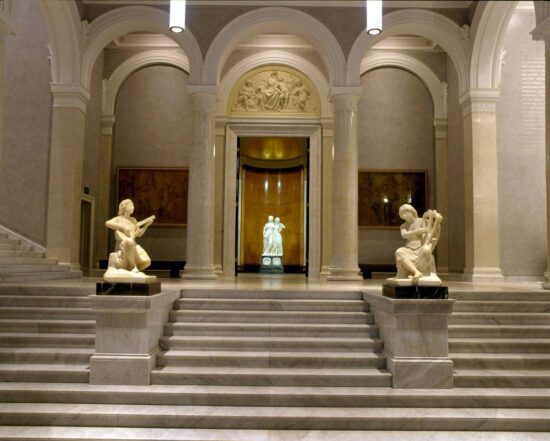Alte Nationalgalerie
Last but not least the Alte Nationalgalerie. The reopening of the Alte Nationalgalerie in December 2001 marked the beginning of the revival of the Museum Island and set standards in terms of architecture, preservation of historical monuments, and conceptual design. The architects’ office of HG Merz was in charge of the complete renovation.
Based on sketches by Friedrich Wilhelm IV, the museum was designed by Friedrich August Stüler between 1862 and 1865. After Stüler’s death, the construction of the impressive building was carried out by Johann Heinrich Strack. In 1876 it opened as the “Nationalgalerie.” Just as back then, sculptures and paintings from the 19th century are presented in the museum today.


Visible from quite a distance, the temple-like building of the Alte Nationalgalerie towers above the eastern side of the Museum Island. It is enclosed by a colonnaded hallway. The resulting Colonnade Courtyard – Stüler’s Arcadia – was reopened in 2010.
With its tall base and the stairway dominating the front of the main façade, the building, which was opened in 1876, became a monument to the newly emerging patriotic self-confidence of the time. This aspect is also emphasized by the programmatic inscription in the gable: “Dedicated to German Art.” At the time it was built, Alte Nationalgalerie was designed as a location for what was then contemporary art.



At first, it housed only German art ranging from the Enlightenment to Impressionism. Around 1900 the collection began to include French paintings. The new concept with its international outlook entailed far-reaching structural changes to the interior of the building, thereby creating additional exhibition space.
Today, the collection features artists ranging from Caspar David Friedrich and Johann Gottfried Schadow to Carl Blechen and Adolph Menzel and includes French Impressionism represented by Edouard Manet and Paul Cézanne. Lovis Corinth and the early works of Max Beckmann mark the transition to modern art and the Neue Nationalgalerie at the Kulturforum. More



